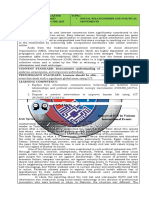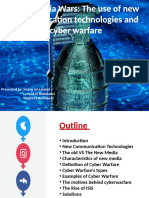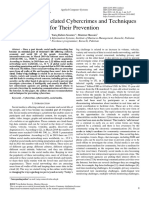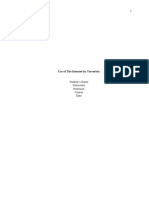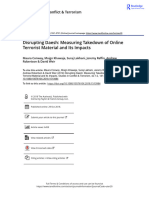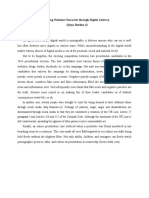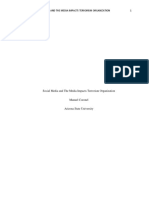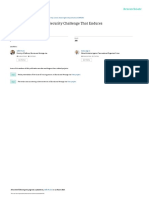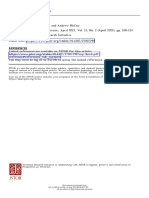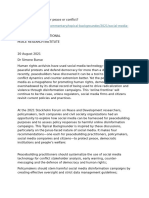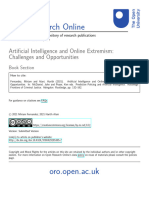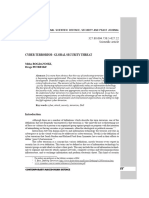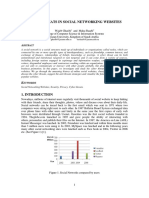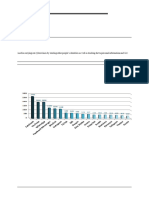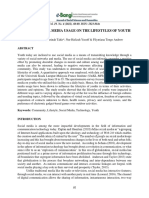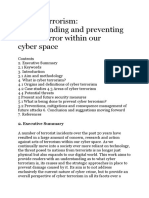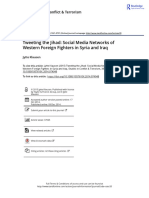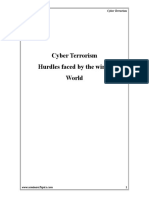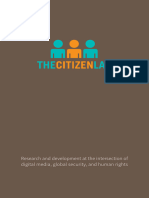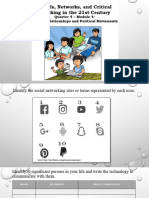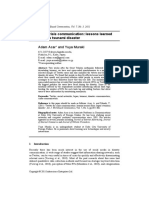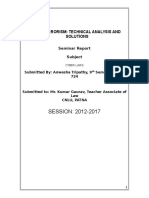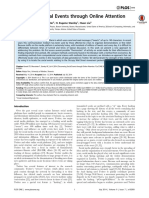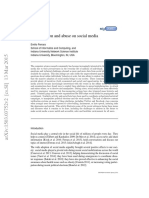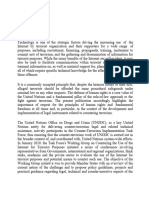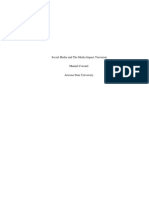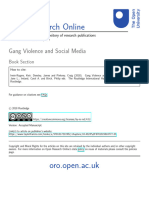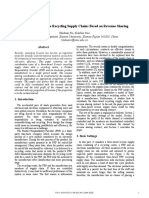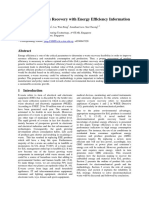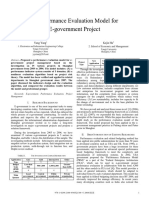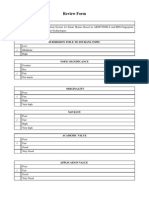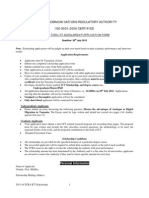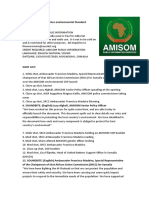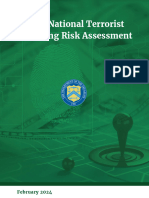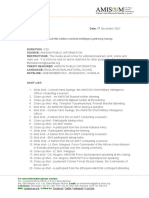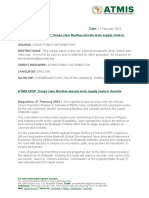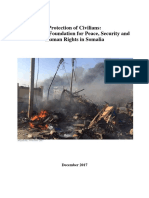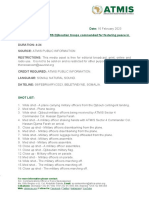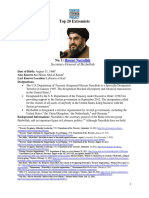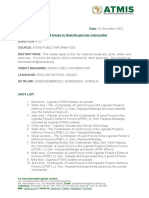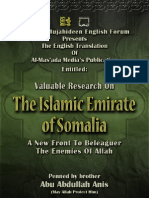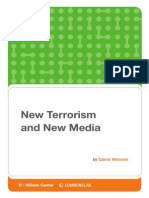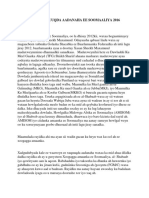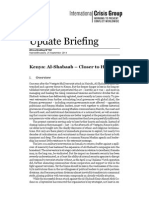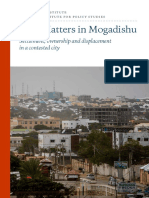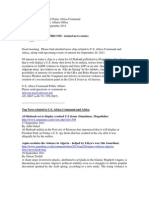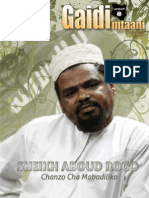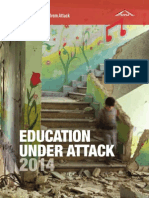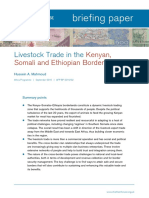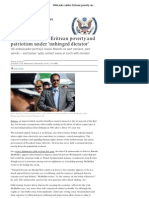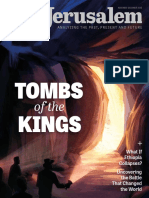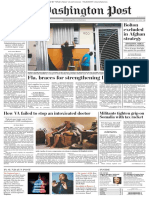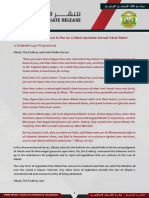Fredrick Ishengoma - Online OSNs and Terrorism 2.0 in Developing Countries
Fredrick Ishengoma - Online OSNs and Terrorism 2.0 in Developing Countries
Uploaded by
Fredrick IshengomaCopyright:
Available Formats
Fredrick Ishengoma - Online OSNs and Terrorism 2.0 in Developing Countries
Fredrick Ishengoma - Online OSNs and Terrorism 2.0 in Developing Countries
Uploaded by
Fredrick IshengomaOriginal Description:
Copyright
Available Formats
Share this document
Did you find this document useful?
Is this content inappropriate?
Copyright:
Available Formats
Fredrick Ishengoma - Online OSNs and Terrorism 2.0 in Developing Countries
Fredrick Ishengoma - Online OSNs and Terrorism 2.0 in Developing Countries
Uploaded by
Fredrick IshengomaCopyright:
Available Formats
International journal of Computer Science & Network Solutions December.2013-Volume 1.
No4
http://www.ijcsns.com ISSN 2345-3397
57
Online Social Networks and Terrorism 2.0 in
Developing Countries
A. Fredrick Romanus Ishengoma
College of Informatics and Virtual Education, The University of Dodoma, Dodoma, Tanzania.
ishengomaf@gmail.com
Abstract
The advancement in technology has brought a new era in terrorism where Online Social Networks (OSNs)
have become a major platform of communication with wide range of usage from message channeling to
propaganda and recruitment of new followers in terrorist groups. Meanwhile, during the terrorist attacks
people use OSNs for information exchange, mobilizing and uniting and raising money for the victims. This
paper critically analyses the specific usage of OSNs in the times of terrorisms attacks in developing
countries. We crawled and used Twitters data during Westgate shopping mall terrorist attack in Nairobi,
Kenya. We then analyzed the number of tweets, geo-location of tweets, demographics of the users and
whether users in developing countries tend to tweet, retweet or reply during the event of a terrorist attack.
We define new metrics (reach and impression of the tweet) and present the models for calculating them.
The study findings show that, users from developing countries tend to tweet more at the first and critical
times of the terrorist occurrence. Moreover, large number of tweets originated from the attacked country
(Kenya) with 73% from men and 23% from women where original posts had a most number of tweets
followed by replies and retweets.
Keywords: Developing Countries, Online Social Networks, Terrorism 2.0, Twitter and Westgate.
I. Introduction
Online Social Networks (OSNs) example Twitter, Facebook, and YouTube have emerged as
major means of communication for people in sharing and exchanging information on a wide
variety of real-world events. As technology and Internet advances in developing countries, users
from developing regions are also increasing in using OSNs (Reda, 2012). Numerous studies have
shown that users from developing countries are spending a significant amount of time in OSNs
(Karel 2007; Reda 2011). Another OSNs study (Pew Research Center, 2010) showed many
people in developing countries do not go online, however when they have the opportunity to go
online, they tend to use online social networking sites. For example, one-in-five Kenyans (19%)
participate in online social networking, while just 5% use the Internet but do not participate.
Of the users that go online in developing countries, the demographics have shown a double-digit
difference in gender gap where more men tend to go online compared to women (Pew Research
Center, 2010; Intel, 2013). A recently study by Intel showed that on average, 23% fewer women
than men are online in developing countries (Intel, 2013).
While the OSNs users can use the technology positively for communication and information
exchange, yet the same technology can also be used negatively as a tool for terrorism 2.0.
Terrorism 2.0 is the use of web 2.0 applications and semantic technologies in assisting or
International journal of Computer Science & Network Solutions December.2013-Volume 1.No4
http://www.ijcsns.com ISSN 2345-3397
58
performing terrorist acts. With web 2.0, terrorist are able to connect them using social networks
for sharing information, disseminate propaganda, recruiting new members and even planning an
attack. For example, Al-Shabaab, a terrorist group based in Somalia, used Twitter during a
Westgate terrorist attack in Nairobi to disseminate information and claiming responsibility of the
attack.
Meanwhile, during terrorist attacks people have been using these OSNs to break the news,
provide information with rich media content and uniting people for providing help and
fundraising for the victims. For example, during the Westgate attack Twitter was used to
mobilize the country for blood donation, money donation as well as keeping the peace. People
used the hashtag #WeAreOne for uniting the country through updates and insights and raising
money for the victims.
The aim of this paper is to analyze how OSNs is being used during the event of a terrorist attacks
in developing countries along. We perform activity analysis of Twitter after the Westgate attack
in Nairobi. Moreover, we present the OSNs challenges and opportunities in relation to terrorism
2.0. The rest of the paper is organized as follows: We start by providing related work in section
2. Section 3 is dedicated to the background of terrorism 2.0 and OSNs. Section 4 discuses
Twitter in the era of Terrorism 2.0 with subsections on how people use Twitter and Twitter as a
terrorist assistance tool. Data collection is discussed in Section 5. Section 6 discuses and analyses
the findings of the study. We conclude in Section 7.
II. Related Work
In this section, we provide an overview of various studies that are related to our research work.
A number of studies (Murthy, 2010; Mendoza, 2010, Stollberg, 2012; Nagar, 2012; Hossmann,
2012) have focused their work on the usage of OSNs during disasters like floods and earthquakes
and in facilitating event detection and responses to emergency situations (Becker, Naaman, and
Gravano 2011; Li, Sun, and Datta 2012; Li et al. 2012; Weng et al. 2011).
Weimann (Weimann, 2011) describes how the advances of technology has changed terrorist
online communication from one-directional to bi-directional with interactive capabilities like
chat-rooms, online social networking sites, video-sharing sites. (Veerasamy, 2012) represented
the functions and methods that terrorists have come to rely on through the Information and
Communication Technology (ICT) infrastructure. The discussion sheds light on the technical and
practical role that ICT infrastructure plays in the assistance of terrorism.
(Gupta, 2011) attempt to characterize and extract patterns of activity of users on Twitter during a
crisis based on the Mumbai terrorist attack. The study attempted to characterize and extract
patterns of activity of users on Twitter during a terrorist situation. Another close related work is
by Oh and Agrawal, (Oh, 2011). They analyzed the Twitter stream during the 2008 Mumbai
terrorist attacks. The study applied social awareness theory to show how information available
on OSNs during the attacks aided the terrorists decision making.
International journal of Computer Science & Network Solutions December.2013-Volume 1.No4
http://www.ijcsns.com ISSN 2345-3397
59
While some of the studies have the similar objectives with our study, our study remains unique
as it focuses on a OSNs usage during terrorists attack in a developing country context.
III. Terrorism 2.0 and Online Social Networks
In this section we will provide an introductory overview of Terrorism 2.0 and Online Social
Networks (OSNs) and how they are related.
A. Terrorism 2.0
As Information and Communication Technologies (ICTs) advances and transform how we live,
it also changes the terrorism era. Advances in IT has brought a new era of Terrorism 2.0 where
terrorist now make use of high advancement of IT to accomplish their goals. OSNs have now
been used by terrorists for communication, recruiting new members, transmitting training videos
and materials and propaganda.
For example, one terrorist website provide details on how to make Improvised Explosive
Devices (IEDs), a bomb that can be made from locally available materials. Other terrorist
websites have been distributing materials (tutorials and books) online on how to make poisons,
bombs and conduct a terrorist attack. Some of the popular terrorist books that circulate online are
The Mujahideen Poisons Handbook and The Anarchists Cookbook.
B. Online Social Networks
Online Social Networking Sites (OSNs) are kind of social media that gives ability online user to
make a profile with his information and enable users to share and exchange messages and
multimedia content (Boyd & Ellison, 2008). Some examples of popular social networks include
Facebook, Twitter, YouTube and Flickr. They depend on peer-to-peer (P2P) networks that are
cooperative, distributed, and community driven. Within the OSNs users can create groups for
people with common interest to share information and communicate privately.
Recently, terrorists have changed from its traditional ways of communicating to adapt the use of
OSNs as their platform of communication. OSNs has opened a new way to terrorists enabling
them to communicate easily and more secure, disseminate information, propaganda and training
materials, organize attacks, recruiting new members and to seek sympathy to the public for their
actions worldwide.
IV. Twitter in the Era of Terrorism 2.0
With registered users more than 500 million worldwide as of October 2013, Twitter is one of the
most popular online social networks available. Twitter offers exchange of short messages called
Tweets of up to 140 characters long between its users. Hashtags are words prefixed with !#
used by Twitter users to describe a subject (e.g. #BreakingNews). Common practice of
responding to a tweet has evolved into well-defined mark-up culture: RT stands for Retweet. A
retweet is a message from one user that is forwarded by a second user. The retweet mechanism
empowers users to spread information of their choice beyond the reach of the original tweets
International journal of Computer Science & Network Solutions December.2013-Volume 1.No4
http://www.ijcsns.com ISSN 2345-3397
60
followers. A message from one Twitter user that is a response to Twitter users message is called
a Reply. Being a follower on Twitter means that the user receives all the tweets from those the
user follows. We opted to use Twitter as our choice of OSN for this study due to its availability
of data.
A. How people use Twitter?
Studies have shown that people use Twitter for different purposes (Java, 2007; Ramage, 2010;
Naaman, 2010) studied the aims of 94,000 Twitter users with more than 1.3 million tweets and
concluded that users make use of Twitter in the following major areas:
(i) Chatting. Most Twitter users are for discussion of day-to-day activities.
(ii) Conversations. Some of the Twitter users engage in the conversation using replies
mechanism.
(iii) Information exchange/Sharing. Twitter users share and exchange information through
Twitter posts contains URLs.
(iv) News. Reporting and commenting on breaking news and latest news is another type of
peoples usage in Twitter.
B. Twitter as a Terrorist Assistance Tool
OSN is a suitable platform for terrorists because of its easy access, little control from the
governments, worldwide audience, anonymity (via fake profiles), fast flow of information, cheap
development of OSN websites and multimedia platform (the capability to combine text, graphics,
audio, video and downloading). With the current highly development of Information and
Communication Technologies (ICTs) terrorist uses OSN for the following purposes:
(i) Information exchange. Terrorist use OSN to communicate with worldwide audience than
it was a decade before. Terrorists have become sophisticated in using
anonymous/secret communications using encryption, steganography and anonymity
softwares. Example, Al-Qaeda members have been using encryption softwares
"Mujahedeen Secrets 1# and "Mujahedeen Secrets 2# to encrypt and secure their
email communications.
(ii) Recruiting and Training. A report by the institute of homeland security of the George
Washington University (Homeland Security Institute, 2009) relays that the Internet
has become crucial instrument in the hands of terrorists to spread their messages and
recruit new supporters. Nowadays terrorists recruitment and training can be
successfully offered via OSNs easily and anonymously unlike before, which required
the physical meetings of trainees and trainers. Recruits are passing through a series of
tests in password protected websites and restricted chat rooms before accepted and
joining the terrorist group (Gerwehr, 2006). Tactics used includes the integration of
terrorist acts in cartoons and music videos to attract the minors into terrorism. Also,
video games that involve the acts of terrorism like mass suicide attack.
(iii) Planning attacks. OSNs are used by terrorists to plan an attack due to its secure
communication and fast message channeling.
International journal of Computer Science & Network Solutions December.2013-Volume 1.No4
http://www.ijcsns.com ISSN 2345-3397
61
(iv) Fundraising. Through wire transfer and email address the groups are able to conduct a
fundraising in OSNs.
(v) Cyber-attack. Cyber-attack refers to the use of computer networking tools to attack other
computer networks or national communications systems like government operations,
transportation, and energy.
(vi) Propaganda. Though these OSN have played a great role in the society, at the same time
the terrorists is using them for their propaganda dissemination. These propaganda
deals with delivering ideological, clarifications, explanations or campaign of terrorist
actions. These can involve messages, demonstrations, magazines, audio and video
footage of violent acts.
On 16 March 2013, the propaganda arm of al-Qaeda, the Andalus Foundation, created a twitter
account (@Andalus_Media). The account has gained more than 14,500 followers while
following 7 people inclusing the Somali terrorist group Al Shaabab. Al-Shabaab (Kimunguyi
(2010), Ibrahim (2010)) also known as Harakat al-Shabaab al-Mujahideen (HSM) started their
Twitter account in English as HSM Office on December 2011 using the Twitter handle
!@HSMPress (https://twitter.com/#!/HSMPress). HSMPress is the press branch of Al-Shabaab
(HSM). Since then they have been using Twitter to exaggerate their military accomplishments.
Al-Shabaab has been in battle with Kenya (due to presence of Kenyan Army in Somalia) that has
led to Westgate attack in September 2013 Nairobi. The terrorist groups Twitter account has
been repetitive suspended by Twitter due to violation of terms of service. Twitters terms of
service state that users "may not publish or post direct, specific threats of violence against
others.# However each time their account is suspended, they create new accounts with some
slight variations on the same name such as @HSMPRESS1, @HSM_PressOffice,
@HSM_PROffice and @HSM_PR.
Figure. 1. Cover of Al-Shabaabs English Twitter page as of 13 August 2013.
International journal of Computer Science & Network Solutions December.2013-Volume 1.No4
http://www.ijcsns.com ISSN 2345-3397
62
Figure. 2. Example of Al-Shabaabs Tweet during the Westgate attack.
V. Data
Our case study is the terrorist attack of Westgate shopping mall in Nairobi, Kenya on 21st
September 2013. The attack lasted until 24th September resulting in at least 72 deaths and over
200 wounded people (Raidi% Teilif(s *ireann, 2013). The Islamist group Al-Shabaab claimed
accountability for the terrorist attack.
We used Twitter search API during the Westgate attack period when the text string !#Westgate
was most active and Topsy (Topys, 2013), a certified Twitter partner that maintains the worlds
largest index of tweets, numbering in hundreds of billions, dating back to May 2008. We crawled
the data of the popular Twiter #hashtags that was used during the Westgate attack namely;
#Westgate. The #Westgate hashtag was used in tweeting by both the terrorists and the civilians.
We analyzed data between 21st and 27th to obtain the clear picture of the patterns. These data
are analyzed to explore the following metrics:
(i) Number of tweets during the terrorist attack.
(ii) Whether users tend to tweet, retweet or reply in Twitter during the event of
Westgate terrorist attack.
(iii) What countries had the highest frequency of tweets during the Westgate terrorist
attack.
(iv) What are the demographics of the Twitter users during the Westgate terrorist
attack and
(v) What were the reachness and impressions of the tweets during the Westgate
terrorist attack?
VI. Findings and Discussion
In this section we present our findings of the study and discussion. We begin by examining the
number of tweets that were sent during the #Westgate attack. While there were many other
hashtags used to discuss the terrorist attack in Twitter posts (like #Nairobi, #Kenya, #Terrorist),
we chose the #Westgate hashtag since it was the most relevant one and standard one. We
considered the number of tweets that uses only the hashtag !Westgate.
International journal of Computer Science & Network Solutions December.2013-Volume 1.No4
http://www.ijcsns.com ISSN 2345-3397
63
Figure. 3. Number of tweets during the #Westgate attack.
Figure 3 shows the number of tweets tweeted using #Westgate hashtag during the Westgate
attack period between 21st September. The number of tweets is observed to be high during the
first hours of the terrorist attack and when the terrorist attack is in its peak. This is due to the
Twitters real time nature i.e. the behaviour of Twitter users to post about events as they are
happening. The tweets are observed to decrease as the terrorist attack ends.
Figure 4. Geographical distribution of tweets during the #Westgate attack.
Figure 4 shows the geographical distribution of tweets during the Westgate attack. From the
figure it is observed that most of the tweets came from the developing countries. Kenya being the
countries tweeted mostly about the attack, this could be because it is the attacked country. Also,
a significant number of tweets is shown to have originated from US and UK.
We then analyzed the Twitter data to find out, how many tweets were original posts, retweets or
replies using the keyword #Westgate.
International journal of Computer Science & Network Solutions December.2013-Volume 1.No4
http://www.ijcsns.com ISSN 2345-3397
64
Figure 5. Sharing of tweets (original, retweets and replies) during the #Westgate attack.
Figure 5 shows the sharing of Twitter posts during the Westgate attack. From the figure it is
observed that most of the tweets during the attack were original posts (65%), followed by
retweets (27%) and replies (8%).
In figure 6 we analyzed the reach and impression of #Westgate tweets during the terrorist attack.
We define reach, as the number of unique followers that a user has that is, the unique people who
a tweet could potentially get to. We define impression as the number of times a user posts that is,
how many times followers would see these posts. Let N be the number of followers a Twitter
user has and t the number of times a tweet is tweeted. Reach is given by N whereby Nt gives
impression. For example, if a Twitter user has 300 followers In figure 6 we analysed the reach
and impression of #Westgate tweets during the terrorist attack. We define reach, as the number
of unique followers that a user has that is, the unique people who a tweet could potentially get to.
We define impression as the number of times a user posts that is, how many times followers
would see these posts. Let N be the number of followers a Twitter user has and t the number of
times a tweet is tweeted. Reach is given by N whereby Nt gives impression. For example, if a
Twitter user has 300 followers and tweet 3 times then tweets reach is 300 and tweets
impression is 900 (since 300 followers saw the tweet thrice).
International journal of Computer Science & Network Solutions December.2013-Volume 1.No4
http://www.ijcsns.com ISSN 2345-3397
65
Figure 6. Reach and Impression of tweets during the #Westgate attack.
We then analyzed the demography of the Twitter posts during the #Westgate attack. In Figure 7
we could see the percentage of male and female who tweeted about the terrorist attack using
#Westgate hashtag. Males are observed to tweet more than females. 73% of the #Westgate
tweets are observed to be from males while 27% of the #Westgate tweets are from females. This
could be due to the gender gap in developing countries where according to International
Telecommunication Union (ITU, 2013), 16% fewer women than men use the Internet in
developing countries.
Figure 7. Demography of Twitter posts during the #Westgate attack.
VII. Conclusion
International journal of Computer Science & Network Solutions December.2013-Volume 1.No4
http://www.ijcsns.com ISSN 2345-3397
66
In this paper, we analyzed the usage of Online Social Networks (OSNs) in the event of a terrorist
attack with a case study of a Westgate shopping mall attack in Nairobi, Kenya. We used different
metrics like number of tweets, whether users in developing countries tended to tweet, retweet or
reply, demographics, geo-location and we defined new metrics (reach and impression of the
tweet) and presented their models. While the developing countries are faced by many limitations
in using OSNs such as unreliable power and poor Internet connection, still the study finding
challenges the traditional media of reporting during disasters like terrorists attacks. We
recommend centers globally to make full use of the OSNs for crisis communication in order to
save more lives during such.
References
i. Aditi Gupta, Ponnurangam Kumaraguru, Twitter Explodes with Activity in Mumbai
Blasts! A Lifeline or an Unmonitored Daemon in the Lurking? PSOSM '12 Proceedings
of the 1st Workshop on Privacy and Security in Online Social Media, 2012.
ii. Azarias Reda, Sam Shah, Mitur Tiwali, Anita Lillie, Brian Noble, Social Networking in
Developing Regions, Fifth International Conference on Information and Communication
Technologies and Development (ICTD 2012), 2012.
iii. Azarias Reda, Edward Cutrell, and Brian Noble, Towards Improved Web Acceleration:
Leveraging the Personal Web. In Pro- ceedings of the 5th ACM Workshop on Networked
Systems for Developing Regions (NSDR), pages 57 - 62, Bethesda, Maryland, USA,
June 2011.
iv. Beate Stollberg, Tom de Groeve, The Use of Social Media within the Global Disaster
Alert and Coordination System (GDACS), WWW, SWDM'12 Workshop April 16,20,
2012, Lyon, France, 2012.
v. Becker, H.; Naaman, M.; and Gravano, L, Beyond Trending Topics: Real-world Event
Identification on Twitter. In Proc. of WSM, 2011.
vi. Dhiraj Murthy & Scott A. Longwell, Twitter and Disasters: The uses of Twitter during
the 2010 Pakistan floods, May 2012.
vii. Gabriel Weimann, Lone Wolves in Cyberspace, Journal of Terrorism Research, Volume
3, Issue 2, 2012.
viii. Gabriel Wimann, Al Qaeda Has Sent You A Friend Request: Terrorists Using Online
Social Networking, Israeli Communication Association, 2011.
ix. Homeland Security Institute (2009), The Internet as a Terrorist Tool for Recruitment and
Radicalization of Youth, US Department of Homeland Security, Science and Technology
Directorate.
International journal of Computer Science & Network Solutions December.2013-Volume 1.No4
http://www.ijcsns.com ISSN 2345-3397
67
x. Ibrahim, M. (2010), Somalia and Global Terrorism: A Growing Connection? Journal of
Contemporary African studies, Volume 28:3, pp.283-295.
xi. Java, A., X. Song, T. Finin, and B. Tseng, Why We Twitter: Understanding
Microblogging Usage and Communities, In WebKDD/SNA-KDD 07: Proceedings of
the 9th WebKDD and 1st SNA-KDD 2007 Workshop on Web Mining and Social
Network Analysis, New York, NY, USA, pp. 56,65. ACM, 2007.
xii. Karel Matthee, Gregory Mweemba, Adrian Pais, Gertjan van Stam, and Marijn Rijken,
Bringing Internet Connectivity to Rural Zambia Using a Collaborative Approach, In
Proceedings of the 2nd ACM International Conference on Information and
Communication Technologies and Development (ICTD), pages 47,58, Bangalore, India,
December 2007.
xiii. Li, C.; Sun, A.; and Datta, A. Twevent, Segment-based Event De tection from Tweets. In
Proc. of CIKM, 2012.
xiv. Li, R.; Lei, K. H.; Khadiwala, R.; and Chang, K. C.-C. TEDAS: A Twitter-based Event
Detection and Analysis System. In Proc. of ICDE, 2012.
xv. Naaman, M., J. Boase, and C.-H. Lai, Is it Really about Me?: Message Content in Social
Awareness Streams, In Proceedings of the 2010 ACM Conference on Computer
Supported Cooperative Work, CSCW 10, New York, NY, USA, pp. 189,192. ACM,
2010.
xvi. Marcelo Mendoza, Barbara Poblete, and Carlos Castillo. Twitter Under Crisis: Can We
Trust What We RT? In 1st Workshop on Social Media Analytics (SOMA 10). ACM
Press, July 2010.
xvii. Onook Oh, Manish Agrawal, and H. Raghav Rao. Information Control and Terrorism:
Tracking the Mumbai Terrorist Attack through Twitter. Information Systems Frontiers,
13(1):33,43, 2011.
xviii. Patrick Kimunguyi (2010), Terrorism and Counter Terrorism in East Africa, Global
Terrorism Centre, 2010.
xix. Pew Research Center. Global Publics Embrace Social Networking. Pew Global Attitudes
Project, 2010.
xx. Raidi% Teilif(s *ireann, Kenyan Military Frees Most Hostages at Mall, 23 September
2013. Retrieved 24 September 2013.
xxi. Ramage, D., S. Dumais, and D. Liebling, Characterizing Microblogs with Topic Models.
In ICWSM, 2010.
International journal of Computer Science & Network Solutions December.2013-Volume 1.No4
http://www.ijcsns.com ISSN 2345-3397
68
xxii. Seema Nagar, Aaditeshwar Seth, Anupam Joshi, Characterization of Social Media
Response to Natural Disasters), WWW, SWDM'12 Workshop April 16,20, 2012, Lyon,
France, 2012.
xxiii. Scott Gerwehr and Sarah Daly (2006), Al-Qaida: Terrorist Selection and Recruitment, in
The McGraw-Hill Homeland Security Handbook, David Kamien, ed. (New York,
McGraw-Hill), pp. 83.
xxiv. Theus Hossmann, Paolo Carta, Dominik Schatzmann, and Franck Legendre, Per
Gunningberg, Christian Rohner, Twitter in Disaster Mode: Security Architecture,
Proceedings of the Special Workshop on Internet and Disasters. Tokyo, Japan: ACM,
2011.
xxv. Weng, J.; Yao, Y.; Leonardi, E.; and Lee, F. Event Detection in Twitter. In Proc. of
WSM, 2011
You might also like
- Fredrick Ishengoma - Online Social Networks and Terrorism 2.0 in Developing CountriesDocument12 pagesFredrick Ishengoma - Online Social Networks and Terrorism 2.0 in Developing CountriesFredrick IshengomaNo ratings yet
- Best BookDocument18 pagesBest Bookmuhammad sheharyarNo ratings yet
- Digital terrorismDocument16 pagesDigital terrorismp18631801No ratings yet
- Q3 Module 4Document4 pagesQ3 Module 4Alex Abonales DumandanNo ratings yet
- en Radikalisme Agama Legitimasi Tafsir KekeDocument254 pagesen Radikalisme Agama Legitimasi Tafsir KekeretnoNo ratings yet
- AN INVESTIGATION INTO THE ROLE OF SOCIAL MEDIA USAGE AND CONSUMPTION IN THE PROMOTION OF CYBERCRIME BY UNDERGRADUATES IN NIGERIADocument6 pagesAN INVESTIGATION INTO THE ROLE OF SOCIAL MEDIA USAGE AND CONSUMPTION IN THE PROMOTION OF CYBERCRIME BY UNDERGRADUATES IN NIGERIAadeoye abassNo ratings yet
- New Nedia WarsDocument25 pagesNew Nedia Warsayoub addiNo ratings yet
- Social Media-Related Cybercrimes and Techniques FoDocument9 pagesSocial Media-Related Cybercrimes and Techniques FoFarhan FarukNo ratings yet
- 1954408Document10 pages1954408jadrienjabali09No ratings yet
- The Use of Media by ISIS in The Paris AttackDocument5 pagesThe Use of Media by ISIS in The Paris AttackHoàng LongNo ratings yet
- Can Cyber Crime Be Done Through Social Media?Document30 pagesCan Cyber Crime Be Done Through Social Media?Rohit SharmaNo ratings yet
- TerriorismDocument9 pagesTerriorismoluwoleayomide00No ratings yet
- A Case Study On Clickjacking Attack and Location LeakageDocument12 pagesA Case Study On Clickjacking Attack and Location LeakageRamona DinescuNo ratings yet
- Order 3605767 EditedDocument6 pagesOrder 3605767 Editedonka melissaNo ratings yet
- Al Khateeb2019Document26 pagesAl Khateeb2019Shawn AlexanderNo ratings yet
- Process Work 7Document4 pagesProcess Work 7api-429759622No ratings yet
- Cyberbullying Detection System On TwitterDocument11 pagesCyberbullying Detection System On Twitterbibek singhNo ratings yet
- A Survey On The Use of Social Media Among PublicDocument10 pagesA Survey On The Use of Social Media Among PublicWan AzamNo ratings yet
- Q2Mo4 Social Relationships and Political MovementsDocument15 pagesQ2Mo4 Social Relationships and Political MovementszelsambalodNo ratings yet
- Disrupting Daesh Measuring Takedown of Online Terrorist Material and Its ImpactsDocument21 pagesDisrupting Daesh Measuring Takedown of Online Terrorist Material and Its ImpactsDaniel TorresNo ratings yet
- Final Project Translation ResultDocument10 pagesFinal Project Translation ResultTes AkunNo ratings yet
- Explanatory PaperDocument8 pagesExplanatory Paperapi-429759622No ratings yet
- Onlineradicalization Finalversion PDFDocument24 pagesOnlineradicalization Finalversion PDFAngie MontenegroNo ratings yet
- I S M: A I T S 2011 E R: Nfluence in Ocial Edia N Nvestigation of Weets Panning The Gyptian EvolutionDocument36 pagesI S M: A I T S 2011 E R: Nfluence in Ocial Edia N Nvestigation of Weets Panning The Gyptian Evolutionasmaa EELUNo ratings yet
- Article 4 IPRI Journal XXI 2 Muhammad Rehan Rasheed Moazzam NaseerDocument35 pagesArticle 4 IPRI Journal XXI 2 Muhammad Rehan Rasheed Moazzam NaseerfarzanaNo ratings yet
- This Content Downloaded From 182.18.206.24 On Thu, 19 Aug 2021 00:46:00 UTCDocument26 pagesThis Content Downloaded From 182.18.206.24 On Thu, 19 Aug 2021 00:46:00 UTCQuishNo ratings yet
- Social MediaDocument10 pagesSocial MediaVictor tubilanNo ratings yet
- Artificial Intelligence and Online Extremism: Challenges and OpportunitiesDocument32 pagesArtificial Intelligence and Online Extremism: Challenges and OpportunitiesNorthland ExplorersNo ratings yet
- Weaponization of Social Media - Final Report 2019Document53 pagesWeaponization of Social Media - Final Report 2019Tesfaye MekonenNo ratings yet
- Cyber Terrorism Global Security ThreatDocument14 pagesCyber Terrorism Global Security ThreatKhoi DangNo ratings yet
- Cyber Threats in Social Networking WebsitesDocument8 pagesCyber Threats in Social Networking Websitesraid87No ratings yet
- 4947-Article Text-9198-1-10-20210503Document10 pages4947-Article Text-9198-1-10-20210503pritijagtap1818No ratings yet
- Influence of Social Media On The Interpersonal Communication Skills of Senior High School Students at Cotabato City InstituteDocument12 pagesInfluence of Social Media On The Interpersonal Communication Skills of Senior High School Students at Cotabato City InstituteRolly DiamondNo ratings yet
- QUOTES On WEB 2.ODocument14 pagesQUOTES On WEB 2.Ojacob_robinNo ratings yet
- Analisis Framing Kontra Narasi Terorisme Dan RadikalismeDocument20 pagesAnalisis Framing Kontra Narasi Terorisme Dan Radikalismedina triwijayantiNo ratings yet
- E-Revolutions and Cyber Crackdowns: User-Generated Content and Social Networking in Protests in MENA and BeyondDocument7 pagesE-Revolutions and Cyber Crackdowns: User-Generated Content and Social Networking in Protests in MENA and BeyondAlexComninosNo ratings yet
- Effect of Social Media Usage On The Lifestyles of Youth: Vol. 19. No. 4 (2022) - 60-69. ISSN: 1823-884xDocument11 pagesEffect of Social Media Usage On The Lifestyles of Youth: Vol. 19. No. 4 (2022) - 60-69. ISSN: 1823-884xEstrada, Dominic F.No ratings yet
- Cybercrime Multifaceted One - MitaliDocument22 pagesCybercrime Multifaceted One - MitalimitaliNo ratings yet
- Cyber TerrorismDocument21 pagesCyber TerrorismpraveenNo ratings yet
- Tweeting The Jihad: Social Media Networks of Western Foreign Fighters in Syria and IraqDocument23 pagesTweeting The Jihad: Social Media Networks of Western Foreign Fighters in Syria and IraqAdriana StanescuNo ratings yet
- Cyber Terrorism ReportDocument26 pagesCyber Terrorism ReportNithin Prem ChandNo ratings yet
- Introducing Social Media Intelligence (SOCMINT)Document19 pagesIntroducing Social Media Intelligence (SOCMINT)Rafael Robinson100% (1)
- LT 1Document4 pagesLT 1P S ShahilNo ratings yet
- Citizen Lab Booklet P EDocument20 pagesCitizen Lab Booklet P Epasqual32No ratings yet
- Lesson 13 Social Relationships and Political MovementsDocument11 pagesLesson 13 Social Relationships and Political Movementsella evaristo100% (1)
- Acar, Muraki - 2011 - Twitter For Crisis Communication Lessons Learned From Japan's Tsunami DisasterDocument11 pagesAcar, Muraki - 2011 - Twitter For Crisis Communication Lessons Learned From Japan's Tsunami DisasterFalNo ratings yet
- Anwesha CyberDocument29 pagesAnwesha CyberAnwesha TripathyNo ratings yet
- Awan Sutch Carter Extremism OnlineDocument29 pagesAwan Sutch Carter Extremism OnlineMuhammad WaseemNo ratings yet
- Discovering Social Events Through Online Attention: Dror Y. Kenett, Fred Morstatter, H. Eugene Stanley, Huan LiuDocument7 pagesDiscovering Social Events Through Online Attention: Dror Y. Kenett, Fred Morstatter, H. Eugene Stanley, Huan Liujbsimha3629No ratings yet
- Perception of The Use of Twitter As A Tool For Spreading Fake News Among Students in Kwara State UniversityDocument31 pagesPerception of The Use of Twitter As A Tool For Spreading Fake News Among Students in Kwara State UniversityAPEX MEDIANo ratings yet
- Manipulation and Abuse On SDocument9 pagesManipulation and Abuse On STomás Lucas SelomboNo ratings yet
- Annotated Outline and Reference ListDocument10 pagesAnnotated Outline and Reference Listandrew_torrisNo ratings yet
- Charlees, HoltonDocument4 pagesCharlees, HoltonKhánh Linh LâmNo ratings yet
- A Thematic Review On Digital Storytelling (DST) in Social MediaDocument33 pagesA Thematic Review On Digital Storytelling (DST) in Social MediaJOVINER LACTAMNo ratings yet
- Chapter Two For JunaidDocument23 pagesChapter Two For JunaidoluwaseunNo ratings yet
- Technica EditorialDocument116 pagesTechnica Editorialwalaaelbasha17No ratings yet
- Process Work 9Document9 pagesProcess Work 9api-429759622No ratings yet
- Gang Violence and Social Media v12 KIR JD & CPDocument22 pagesGang Violence and Social Media v12 KIR JD & CPnandirewaNo ratings yet
- The Consequences of The Internet 1Document10 pagesThe Consequences of The Internet 1Ahmed BakirNo ratings yet
- Wireless Electronic Notice Board Using GSM: TechnologyDocument5 pagesWireless Electronic Notice Board Using GSM: TechnologyFredrick IshengomaNo ratings yet
- Adoption of Electronic PatientDocument117 pagesAdoption of Electronic PatientFredrick IshengomaNo ratings yet
- The Leaching Gold and Silver From E-Waste by LSSS Method: Li Jing-Ying Huang LuDocument4 pagesThe Leaching Gold and Silver From E-Waste by LSSS Method: Li Jing-Ying Huang LuFredrick IshengomaNo ratings yet
- Ewaste Business ModelDocument4 pagesEwaste Business ModelFredrick IshengomaNo ratings yet
- 3 Tiered EwasteDocument5 pages3 Tiered EwasteFredrick IshengomaNo ratings yet
- Improving Ewaste RecoveryDocument6 pagesImproving Ewaste RecoveryFredrick IshengomaNo ratings yet
- Adam Mtaho & Fredrick Ishengoma - Factors Affecting QoS in Tanzania Cellular NetworksDocument8 pagesAdam Mtaho & Fredrick Ishengoma - Factors Affecting QoS in Tanzania Cellular NetworksFredrick IshengomaNo ratings yet
- Ethics and Social Impacts of ISDocument5 pagesEthics and Social Impacts of ISFredrick IshengomaNo ratings yet
- The Data Mining of The E-Government On The Basis o Q Fuzzy LogicDocument4 pagesThe Data Mining of The E-Government On The Basis o Q Fuzzy LogicFredrick IshengomaNo ratings yet
- Egov Performance Evaluation ModelDocument4 pagesEgov Performance Evaluation ModelFredrick IshengomaNo ratings yet
- Performance Impact Analysis With KPP Using Application Response Measurement in E-Government SystemsDocument4 pagesPerformance Impact Analysis With KPP Using Application Response Measurement in E-Government SystemsFredrick IshengomaNo ratings yet
- The Data Mining of The E-Government On The Basis o Q Fuzzy LogicDocument4 pagesThe Data Mining of The E-Government On The Basis o Q Fuzzy LogicFredrick IshengomaNo ratings yet
- Review Form: Submission Title To Jouranl TopicDocument3 pagesReview Form: Submission Title To Jouranl TopicFredrick IshengomaNo ratings yet
- Fredrick Ishengoma - A Novel Design of IEEE 802.15.4 and Solar Based Autonomous Water Quality Monitoring Prototype Using ECHERPDocument13 pagesFredrick Ishengoma - A Novel Design of IEEE 802.15.4 and Solar Based Autonomous Water Quality Monitoring Prototype Using ECHERPFredrick IshengomaNo ratings yet
- Tanzania Communications Regulatory Authority ISO 9001:2008 CERTIFIEDDocument3 pagesTanzania Communications Regulatory Authority ISO 9001:2008 CERTIFIEDFredrick IshengomaNo ratings yet
- EGov - Advantages and ChallengesDocument8 pagesEGov - Advantages and ChallengesFredrick IshengomaNo ratings yet
- Fredrick Ishengoma - Erasure Coding Based Hadoop Distributed File SystemDocument8 pagesFredrick Ishengoma - Erasure Coding Based Hadoop Distributed File SystemFredrick IshengomaNo ratings yet
- AMISOM Launches Environmental Standard Operating ProceduresDocument5 pagesAMISOM Launches Environmental Standard Operating ProceduresAMISOM Public Information ServicesNo ratings yet
- 2024 National Terrorist Financing Risk AssessmentDocument35 pages2024 National Terrorist Financing Risk Assessmentalexandru.draguleanNo ratings yet
- AMISOM and SNA Soldiers Conclude Intelligence Gathering TrainingDocument4 pagesAMISOM and SNA Soldiers Conclude Intelligence Gathering TrainingAMISOM Public Information ServicesNo ratings yet
- ATMIS UPDF Troops Clear Buufow-Janaale Main Supply Route in SomaliaDocument2 pagesATMIS UPDF Troops Clear Buufow-Janaale Main Supply Route in SomaliaAMISOM Public Information ServicesNo ratings yet
- July UN Report of The Monitoring Group On Somalia and EritreaDocument417 pagesJuly UN Report of The Monitoring Group On Somalia and Eritreamuigwithania100% (1)
- Protection of Civilians: Building The Foundation For Peace, Security and Human Rights in Somalia (UN Report - December 2017)Document39 pagesProtection of Civilians: Building The Foundation For Peace, Security and Human Rights in Somalia (UN Report - December 2017)Rafister2k13No ratings yet
- Outgoing ATMIS Djiboutian Troops Commended For Fostering Peace in SomaliaDocument3 pagesOutgoing ATMIS Djiboutian Troops Commended For Fostering Peace in SomaliaAMISOM Public Information ServicesNo ratings yet
- Top 20 Extremists - 121820Document38 pagesTop 20 Extremists - 121820PamelaPamdesignNo ratings yet
- Uganda ATMIS Troops in Somalia Get New CommanderDocument5 pagesUganda ATMIS Troops in Somalia Get New CommanderAMISOM Public Information ServicesNo ratings yet
- Islamic Emirate of SomaliaDocument11 pagesIslamic Emirate of SomaliaDefenderofthelandsNo ratings yet
- Senior Leadership of AMISOM Meet With Governor of Lower Shabelle Region To Discuss Liberated Towns - Sabiid and BariireDocument2 pagesSenior Leadership of AMISOM Meet With Governor of Lower Shabelle Region To Discuss Liberated Towns - Sabiid and BariireAMISOM Public Information ServicesNo ratings yet
- New Terrorism and New MediaDocument20 pagesNew Terrorism and New MediaThe Wilson CenterNo ratings yet
- Warbixinta Xuquuqda Aadanaha Ee Soomaaliya 2016Document51 pagesWarbixinta Xuquuqda Aadanaha Ee Soomaaliya 2016Hamud Husein Du'aleNo ratings yet
- Kenya Al Shabaab Closer To Home PDFDocument20 pagesKenya Al Shabaab Closer To Home PDFtloramsNo ratings yet
- This Content Downloaded From 81.255.71.169 On Fri, 27 May 2022 10:51:51 UTCDocument21 pagesThis Content Downloaded From 81.255.71.169 On Fri, 27 May 2022 10:51:51 UTCJoGuerinNo ratings yet
- Land Matters in Mogadishu: Settlement, Ownership and Displacement in A Contested CityDocument111 pagesLand Matters in Mogadishu: Settlement, Ownership and Displacement in A Contested CityMohamed Ali MohamedNo ratings yet
- Somali National Army and AMISOM Launch Joint Operations Coordination Centre (JOCC) in MogadishuDocument4 pagesSomali National Army and AMISOM Launch Joint Operations Coordination Centre (JOCC) in MogadishuAMISOM Public Information ServicesNo ratings yet
- Pathways To Peace in The Horn of Africa: What Role For The US?Document21 pagesPathways To Peace in The Horn of Africa: What Role For The US?The Wilson CenterNo ratings yet
- AFRICOM Related News Clips 29 September 2011Document35 pagesAFRICOM Related News Clips 29 September 2011U.s. Africa CommandNo ratings yet
- 6 Dead, 6 Missing in Ferry Capsize in Chindwin River Near KalewaDocument16 pages6 Dead, 6 Missing in Ferry Capsize in Chindwin River Near KalewaZaw ZawNo ratings yet
- US Kansas Intelligence Fusion Center Nairobi Westgate Mall Attack Lessons LearnedDocument15 pagesUS Kansas Intelligence Fusion Center Nairobi Westgate Mall Attack Lessons LearnedWilly OcksNo ratings yet
- Gaidi Mtaani Issue 3 (March 2013)Document42 pagesGaidi Mtaani Issue 3 (March 2013)BillaoJournalNo ratings yet
- Education Under AttackDocument260 pagesEducation Under AttackTeachers Without Borders100% (1)
- R V Hussein Hassan AgadeDocument118 pagesR V Hussein Hassan AgadeBALUKU JIMMYNo ratings yet
- Somalia - Mogadishu NightlifeDocument2 pagesSomalia - Mogadishu NightlifeAMISOM Public Information ServicesNo ratings yet
- KenyaDocument16 pagesKenyaMohamed AliNo ratings yet
- WikiLeaks Cables Eritrea Guardian - CoDocument15 pagesWikiLeaks Cables Eritrea Guardian - CoyekaaloNo ratings yet
- WJ202011 enDocument32 pagesWJ202011 enDr. Gerard J. RemillardNo ratings yet
- The Washington Post (31.08.19)Document50 pagesThe Washington Post (31.08.19)Rita de Cassia Ofrante0% (1)
- A Call To Repentance PDFDocument3 pagesA Call To Repentance PDFAnonymous yF8otSbNo ratings yet



